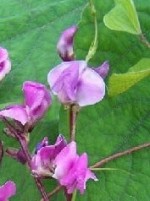 Vines are an excellent way of producing a lot vegetation in a small space because they can grow vertically and hyacinth bean is one of the best annual vines. True, they are perennials in frost free areas where they grow to over 30’ but in zones 9 and colder they are more restrained and grow about 10’ in length. The purple pea-like flowers are borne in loose clusters above the purplish green foliage. If you don’t like purple flowers, white or red ones are available too. Flowers may not be your thing so consider that hyacinth bean also has long purple pods that will attract attention like nothing else. And if you don’t like purple pods, there are cultivars with pale green. Perhaps you see a trend; some hyacinths beans offer variations in flower color, others in pod color and that is not all; cultivars also vary in respect the day length that causes them to bloom and develop fruit. When selecting seed, look at all the characteristics: flower color, pod color, and time of bloom and pod set. Introduced into Europe as Egyptian bean in 1818, it is a great vine for areas that are too hot for sweet peas. If you try it and don’t like it, eat it or feed it to livestock as fodder.
Vines are an excellent way of producing a lot vegetation in a small space because they can grow vertically and hyacinth bean is one of the best annual vines. True, they are perennials in frost free areas where they grow to over 30’ but in zones 9 and colder they are more restrained and grow about 10’ in length. The purple pea-like flowers are borne in loose clusters above the purplish green foliage. If you don’t like purple flowers, white or red ones are available too. Flowers may not be your thing so consider that hyacinth bean also has long purple pods that will attract attention like nothing else. And if you don’t like purple pods, there are cultivars with pale green. Perhaps you see a trend; some hyacinths beans offer variations in flower color, others in pod color and that is not all; cultivars also vary in respect the day length that causes them to bloom and develop fruit. When selecting seed, look at all the characteristics: flower color, pod color, and time of bloom and pod set. Introduced into Europe as Egyptian bean in 1818, it is a great vine for areas that are too hot for sweet peas. If you try it and don’t like it, eat it or feed it to livestock as fodder.
 Type: Annual vine
Type: Annual vine
Bloom: Inch wide fragrant purple, white, red flowers in summer; purple or green 6”pods in fall
Foliage: Trifoliate leaves, each leaflet measuring about 3-6” long and wide, are borne on long slender petioles.
Size: 10-30’ long vines
Light: Full sun
Soil: Low fertility, well-drained soil; drought tolerant once established.
Fertilizer: None needed; good nitrogen fixing plant
Care: Low maintenance
Pests and Diseases: None of significance
Propagation: Seed (difficult to transplant)
Companion plants: With morning glories; in front of leggy plants such as roses to hid unsightly legs.
Outstanding Selection:
‘Ruby Moon” (bicolor pink flowers and purple pods).
